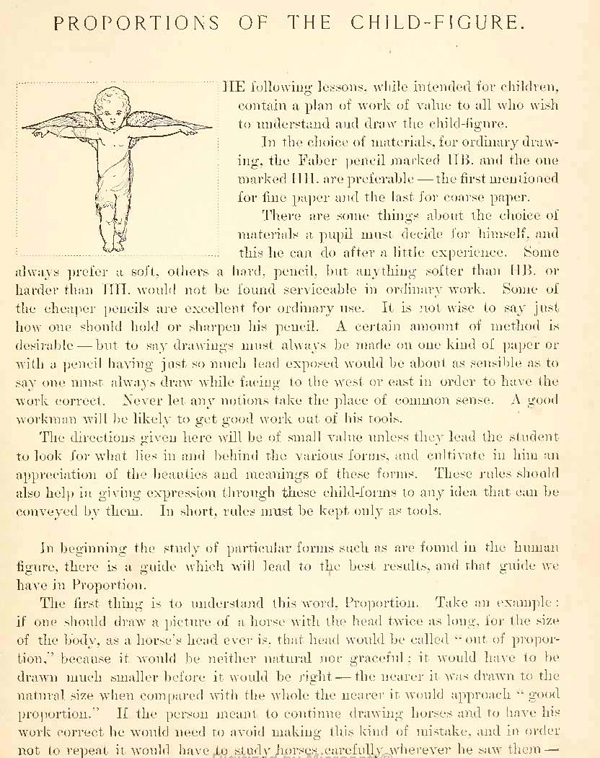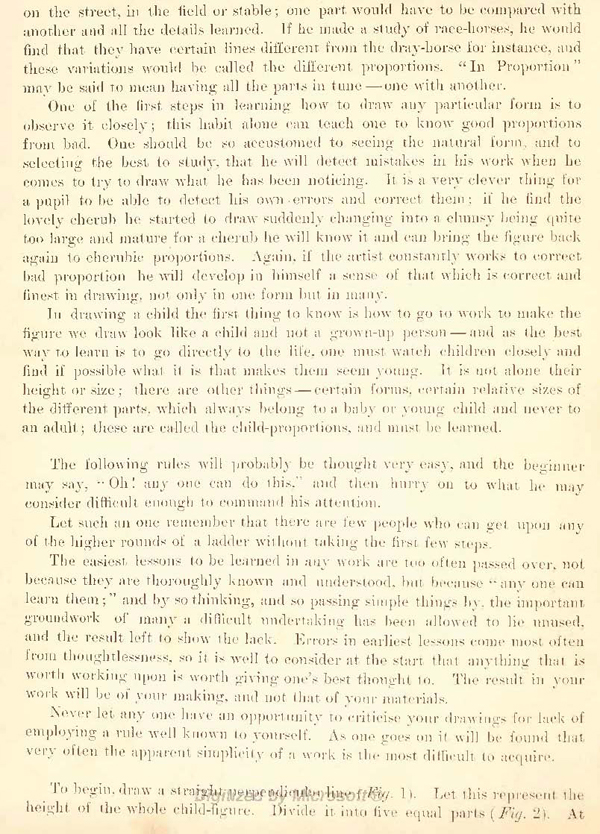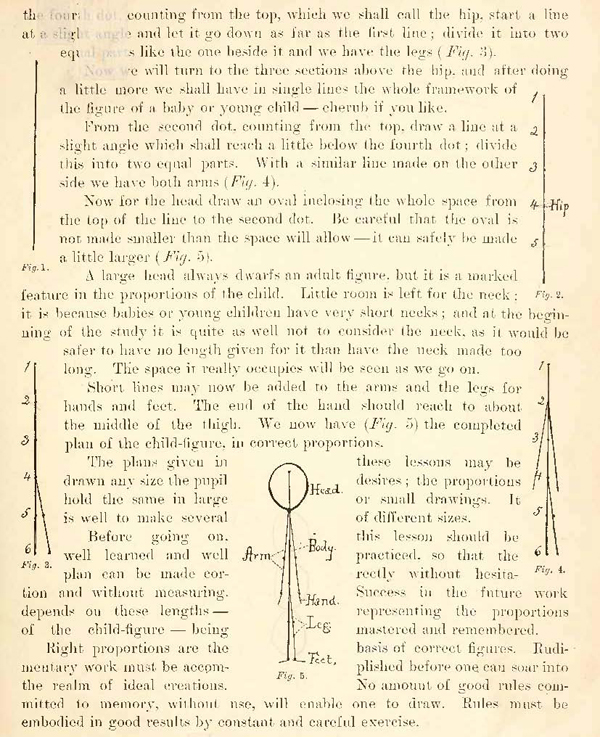Home > Directory of Drawing Lessons >How to Draw People >Proportions of People > The Proportions of Children
CHILDREN'S PROPORTIONS AND MEASUREMENTS and How to Draw Kid's Figures by Knowing the Size of Their Heads in Relation to Other Parts of Their Body
|



[The above words are pictures of text, below is the actual text if you need to copy a paragraph or two]
PROPORTIONS OF THE CHILD-FIGURE.
The following lessons, while intended for children, contain a plan of work of value to all who wish to understand and draw the child-figure.
In the choice of materials, for ordinary drawing, the Faber pencil marked IIB. and the one marked IIIT. are preferable — the first mentioned for fine paper and the last for coarse paper.
There are some things about the choice of materials a pupil must decide for himself, and this lie can do after a little experience. Some always prefer a soft, others a hard, pencil, but anything softer than FIB. or harder than Mt would not be found serviceable in ordinary work. Some of the cheaper pencils are excellent for ordinary use. It is not wise to say just how one should hold or sharpen his pencil. A certain amount of method is desirable — but to say drawings must always be made on one kind of paper or with a pencil having just so much lead exposed would be about a,s sensible as to say one must always draw while facing to the west or east in order to have the work correct. Never let any notions take the place of common sense. A good workman will be likely to get good work out of his tools.
The directions given here will be of small value unless they lead the student to look for what lies in and behind the various forms, and cultivate in him an appreciation of the beauties and meanings of these forms. These rules should also help in giving expression through these child-forms to any idea that can be conveyed by them. In short, rules must be kept only as tools.
In beginning the study of particular forms such a.s are found in the human figure, there is a guide which will lead to tine best results, and that guide we have in Proportion.
The first thing is to understand this word, Proportion. Take an example : if one should draw a picture of a horse with the head twice as long, for the size of the body, as a horse's head ever is, that head would be called out of proportion," because it would be neither natural nor graceful ; it would have to be drawn much smaller before it would be right — the nearer it was drawn to the natural size when compared with the whole the nearer it would approach good proportion." If the person meant to continue drawing horses and to have his work correct he would need to avoid making this kind of mistake, and in order not to repeat it would have wherever he saw them on the street, in the field or stable ; one part would have to be compared with another and all the details learned. If he made a study of race-horses, he would find that they have certain lines different- from the dray-horse for instance, and these variations would be called the different proportions. In Proportion " may be said to mean having all the parts in tune—one with another.
One of the first steps in learning how to draw any particular form is to observe it closely ; this habit alone can teach one to know good proportions from bad. One should be so accustomed to seeing the natural form., and to selecting the best to study, that he will detect mistakes in his work when he comes to try to draw what he has been noticing. It is a very clever thing for a pupil to be able to detect his own .errors and correct- them: if he find the lovely cherub he started to draw suddenly changing into a clumsy being quite too large and mature for a cherub lie will know it and can bring the cherubic proportions. Again. if the artist constantly works to correct bad proportion he will develop in himself a sense of that which is correct and finest in drawing, not only in one form but in many.
In drawing a child the first thing to know is how to go to work to make the figure we draw look like a. child and not a grown-up person—and as the best way to learn is to go directly to the life. one must watch children closely and find if possible what it is that makes them seem young. It is not alone their height or size; there are other things—certain forms. certain relative sizes of the different parts, which always belong to a baby or child and never to an adult; these are called the child-proportions.
The following rules will probably be thought very easy, and the beginner may say, Oh ! any one can do this," and then hurry on to what he may consider difficult enough to command his attention.
Let such an one remember that there are e NV people who can get upon any of the higher rounds of a, ladder without taking the first steps.
The easiest lessons to be learned in any work are too often passed over. not because they are thoroughly known and understood.
but. because any one can learn them; " and by so thinking, and so passing simple things by. the important groundwork of many difficult undertaking has been allowed to lie unused. and the result left to show the lack. Errors in earliest lessons come most often from thoughtlessness, so it is well to consider at the start that anything that is worth working upon is worth (riving one's best thought to.
Never let any one have the opportunity to criticize your drawings for lack of employing a rule well known to yourself. As one goes on it will be found that very often the apparent. simplicity of a work is the most difficult to acquire.
To begin. draw a straight line. Let this represent the height of the whole child. Divide it into five equal parts. Start counting from the top, which we shall call the hip, start a line and let it go clown as far as the first line ; divide it into two like the one beside it and we have the legs (Fig. 3) will turn to the three sections above the hip, and after doing a little more we shall have in single lines the whole framework of the figure of a baby or young child — cherub if you like.
From the second clot, counting from the top, draw a line at a, slight angle which shall reach a. little below the fourth dot; divide this into two equal parts. With a similar line made on the other side we have both arms (Fig. 4).
Now for the head draw an oval inclosing the whole space from the top of the line to the second clot. Be careful that the oval is not made smaller than the space will allow—it can safely be made a little larger (Fig. 5).
A large head always dwarfs an adult figure, but it is a marked feature in the proportions of the child. Little room is left for the neck ; it is because babies or young children have very short necks ; and at the beginning of the study it is quite as well not to consider the neck, as it would be safer to have no length given for it than have the neck made too long. The space it really occupies will be seen as we go on.
Short lines may now bed added to the arms and the legs for hands and feet. The end of the hand should reach to about the middle of the thigh. We now have (Fig.5) the completed plan of the child-figure in correct proportions.
The plans given in these lessons may be drawn any size the pupil desires; the proportions hold the same in large or small drawings. It is well to make several of different sizes.
Before going on, this lesson should be well learned and well practices, so that the plan can be made correctly without hesitation and without measuring. Success in the future work depends on these lengths - being mastered and remembered.
Right proportions are the basis of correct figures. Rudimentary work must be accomplished before one can soar into the realm of ideal creations. No amount of good rules committed to memory, without use, will enable one to draw. Rules must be embodied in good results by constant and careful exercise.




